Figure 3-8.-Coil spring suspension.
Some vehicles are equipped with leaf springs at the
rear wheels only; others are so equipped both front and
rear.
Coil Springs
Coil springs (fig. 3-8) are generally used on
independent suspension systems. They provide a
smooth ride. Their use has normally been limited to
passenger vehicles. Recently, however, they have been
used on trucks.
In figure 3-9, you can see how a coil spring is
mounted. The spring seat and hanger, shaped to fit the
coil ends, hold the spring in place. Spacers of rubberized
material are placed at each end of the coil to prevent
squeaking. The rubber bumper, mounted in the spring
supporting member, prevents metal-to-metal contact
when the spring is compressed. Most vehicles are
equipped with coil springs at the two front wheels, while
some others have them at both front and rear.
SHOCK ABSORBERS
Springs alone cannot meet the requirements for a
light vehicle suspension system. A stiff spring gives a
hard ride, because it does not flex and rebound when the
vehicle passes over a bump. On the other hand, too
flexible a spring rebounds too much, and the vehicle
rides rough. For these reasons, shock absorbers are
needed to smooth the ride of the vehicle. They do so by
keeping the vehicle from jolting too much, by balancing
spring stiffness and flexibility, and by allowing the
springs to return to rest after they are compressed.
Although single-acting shock absorbers check only
spring rebound, double-acting shock absorbers check
spring compression and spring rebound to permit the use
of the more flexible springs.
Figure 3-9.-Coil spring mounting.
3-6




